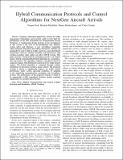| dc.contributor.author | Park, Pangun | |
| dc.contributor.author | Khadilkar, Harshad Dilip | |
| dc.contributor.author | Balakrishnan, Hamsa | |
| dc.contributor.author | Tomlin, Claire | |
| dc.date.accessioned | 2015-05-01T16:55:34Z | |
| dc.date.available | 2015-05-01T16:55:34Z | |
| dc.date.issued | 2014-03 | |
| dc.date.submitted | 2013-07 | |
| dc.identifier.issn | 1524-9050 | |
| dc.identifier.issn | 1558-0016 | |
| dc.identifier.uri | http://hdl.handle.net/1721.1/96872 | |
| dc.description.abstract | Capacity constraints imposed by current air traffic management technologies and protocols could severely limit the performance of the Next Generation Air Transportation System (NextGen). A fundamental design decision in the development of this system is the level of decentralization that balances system safety and efficiency. A new surveillance technology called automatic dependent surveillance-broadcast (ADS-B) can be potentially used to shift air traffic control to a more distributed architecture; however, channel variations and interference with existing secondary radar replies can affect ADS-B systems. This paper presents a framework for managing arrivals at an airport by using a hybrid centralized/distributed algorithm for communication and control. The algorithm combines the centralized control that is used in congested regions with the distributed control that is used in lower traffic density regions. The hybrid algorithm is evaluated through realistic simulations of operations around a major airport. The proposed strategy is shown to significantly improve air traffic control performance under various operating conditions by adapting to the underlying communication, navigation, and surveillance systems. The performance of the proposed strategy is found to be comparable to fully centralized strategies, despite requiring significantly less ground infrastructure. | en_US |
| dc.description.sponsorship | National Science Foundation (U.S.) (Grant CNS-931843) | en_US |
| dc.description.sponsorship | United States. Office of Naval Research. Multidisciplinary University Research Initiative (Grant N0014-08-0696) | en_US |
| dc.description.sponsorship | United States. Office of Naval Research. Multidisciplinary University Research Initiative (Grant N00014-09-1-1051) | en_US |
| dc.description.sponsorship | United States. Office of Naval Research. Multidisciplinary University Research Initiative (Grant N00014-12-1-0609) | en_US |
| dc.description.sponsorship | United States. Air Force Office of Scientific Research. Multidisciplinary University Research Initiative (Grant FA9550-10-1-0567) | en_US |
| dc.language.iso | en_US | |
| dc.publisher | Institute of Electrical and Electronics Engineers (IEEE) | en_US |
| dc.relation.isversionof | http://dx.doi.org/10.1109/TITS.2013.2285116 | en_US |
| dc.rights | Creative Commons Attribution-Noncommercial-Share Alike | en_US |
| dc.rights.uri | http://creativecommons.org/licenses/by-nc-sa/4.0/ | en_US |
| dc.source | MIT web domain | en_US |
| dc.title | Hybrid Communication Protocols and Control Algorithms for NextGen Aircraft Arrivals | en_US |
| dc.type | Article | en_US |
| dc.identifier.citation | Park, Pangun, Harshad Khadilkar, Hamsa Balakrishnan, and Claire Tomlin. “Hybrid Communication Protocols and Control Algorithms for NextGen Aircraft Arrivals.” IEEE Transactions on Intelligent Transportation Systems 15, no. 2 (April 2014): 615–626. | en_US |
| dc.contributor.department | Massachusetts Institute of Technology. Department of Aeronautics and Astronautics | en_US |
| dc.contributor.mitauthor | Khadilkar, Harshad Dilip | en_US |
| dc.contributor.mitauthor | Balakrishnan, Hamsa | en_US |
| dc.relation.journal | IEEE Transactions on Intelligent Transportation Systems | en_US |
| dc.eprint.version | Author's final manuscript | en_US |
| dc.type.uri | http://purl.org/eprint/type/JournalArticle | en_US |
| eprint.status | http://purl.org/eprint/status/PeerReviewed | en_US |
| dspace.orderedauthors | Park, Pangun; Khadilkar, Harshad; Balakrishnan, Hamsa; Tomlin, Claire | en_US |
| dc.identifier.orcid | https://orcid.org/0000-0002-8624-7041 | |
| dspace.mitauthor.error | true | |
| mit.license | OPEN_ACCESS_POLICY | en_US |
| mit.metadata.status | Complete | |
